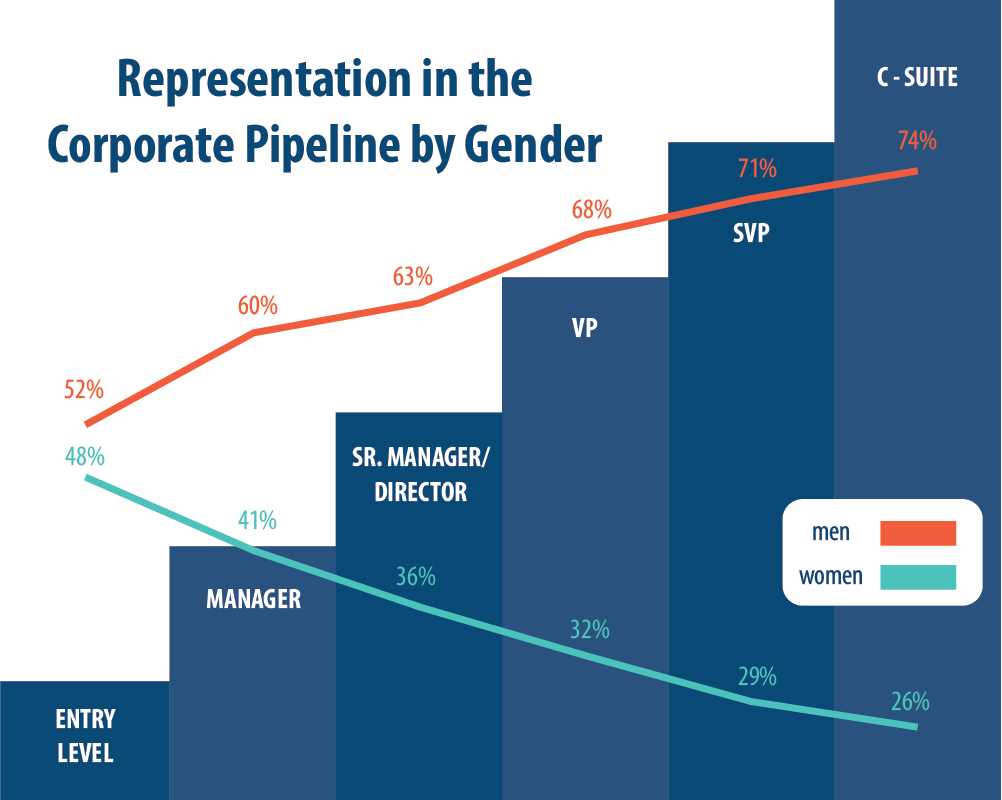
This widening gap occurs because there are disparities in promotion practices and career development opportunities at every rung of the leadership ladder—and because more women leaders are leaving their companies for better opportunities.
The shift in workplaces around the globe due to the COVID-19 pandemic threw a curveball into organizational cultures and revealed some of the challenges women face in career advancement. It became clear that the solution to the lack of women in leadership is not simply to hire more women.
Rather, a systematic approach to fostering women’s career development and advancement through all levels of the corporate pipeline will provide the best environment to improve opportunities for women and organizations as a whole.
The Case for Women in Leadership
Decades of research have demonstrated the positive impact of women leaders on organizations. To start, a study by McKinsey & Co. found that firms that rank in the top quartile for gender diversity in the US are 25% more likely to have better financial performance than the industry mean. Greater gender diversity in top management teams leads to less risk to the firm due to lawsuits, reputation scandals, corruption, and corporate fraud. In relation to internal organizational dynamics, women leaders cue organizational trust and improve perceptions of fair treatment. Harvard Business Review also reported that women score higher than men in 84% of key capabilities that measure leadership effectiveness, such as resilience, integrity, taking initiative, and investing in the development of others.
Gender diversity—in tandem with diversity in race, sexual orientation, and other characteristics—provides a greater variety of ideas, perspectives, and leadership approaches. When organizations tap into this larger pool of possibilities, they find that it improves organizational performance by strengthening the company’s customer orientation, increasing employee satisfaction, facilitating internal team collaboration, and improving decision-making and problem-solving.
At a societal level, the International Monetary Fund writes that “reducing gender disparities results in higher economic growth, greater economic stability and resilience, and lower income inequality.” McKinsey & Co. estimates that if gender gaps in economic productivity were closed, the world economy would be 26% richer.
In the words of IBM, “Women’s advancement is not a women’s issue. It’s an organizational issue.” Organizations that do not invest in women as leaders miss out on the growth, skills, and capacities they can bring to the organization just as much as individual women miss out on the opportunities and development provided by leadership positions.
Gender equity in business leadership is a step toward unlocking the full potential of individual organizations and the global economy.
Women in the Post-Pandemic Workforce
Record numbers of women left the workforce during the Great Resignation brought on by the COVID-19 pandemic. Though no segment of the workforce went unchanged, professional women left their jobs in greater numbers than men. Immediate factors included burnout, a lack of childcare, and safety and health concerns.
Over the next two years, female leaders in particular were more likely than male leaders to question their commitment to jobs where they felt overworked and undervalued; more attracted to companies that value diversity, equity, and inclusion; and more likely to leave organizations for others that offered greater flexibility. And most tellingly, the number one reason cited for switching a job in the two years following the start of the pandemic was opportunity for advancement. In short: “women leaders want to see a seismic shift in the culture of work” that will facilitate their opportunities for leadership.
The unprecedented numbers of women leaving, shifting, and reevaluating their jobs during the COVID-19 pandemic brought attention to some of the unique challenges that women face in career advancement. Savvy organizations are finding solutions to overcome these challenges and attract women back into the workforce and upward into leadership positions.

Barriers Women Face to Advancement in Leadership
First, let’s talk about some of the challenges. Research by Bradley Winn, a professor of leadership and strategy and a MyEducator author, and coauthor Karen Joy Turley, a research assistant and graduate student, focused on identifying and addressing barriers women face that prevent them from advancing in their organizations. Three major barriers are as follows:
Historical and Current Gender Bias
Women may face overt discriminatory practices at work that make the workplace unsafe or unwelcoming, including harassment, sexist comments, and lower pay than men in the same job roles. But often unconsciously, leaders tend to promote people who look, think, and act like themselves. Further, preconceptions about women’s abilities, potential, and commitment to their career sometimes play into hiring and promotion decisions.
Lack of Opportunities for Growth and Development
Women are often given less-challenging assignments at work, hampering their opportunities to both showcase their current abilities and further develop their leadership skills.
Difficulty Managing Work/Life Balance
Work schedules do not always provide the flexibility employees desire to accomplish family responsibilities, especially in top leadership positions where one is expected to be constantly available. Inadequate parental leave policies and inadequate support for women returning from maternity leave also create a barrier to career advancement.
Addressing Gender Disparities in Business Leadership
Now that we understand the benefits of developing and promoting female leaders and the barriers to women’s advancement, let’s consider some solutions. Executive management can make a meaningful difference in addressing gender parity in leadership—and thereby improve the effectiveness and profitability of the entire organization.
The task for organizations today that want to succeed in harnessing the leadership capabilities of women is to create a “healthy pipeline” of diverse candidates for leadership positions. If there are few women available for promotion, then few women will be promoted to the top tiers of management, so we must start further upstream.
Winn and Turley suggest three main areas of focus for executives that will help grow opportunities for women at all levels of the leadership pipeline.
Recognize Biases and Blind Spots
It’s important for current decision makers to understand their own bias and gather information about their potential blind spots. Bias can influence not only individual decisions about hiring and promotion but also larger patterns and policies. For that reason, organizations should investigate hiring practices, advancement criteria, and decision-making processes. Avoid stereotyping or discriminating against employees due to gender or family status.
Further, management can seek to create a culture of inclusion by encouraging all team members to share their perspectives. Take action by using their input to inform decision-making. Gather feedback and listen with the intent to understand.
Proactively Invest in Women Throughout Their Careers
At the entry level, Winn and Turley suggest to executives to “work intentionally, creatively, relentlessly, and non-traditionally to fill your hiring pool with qualified women.” This may include reviewing current hiring practices and sources for bias, implementing internship and sponsorship programs, or strategizing ways to recruit from a more gender-diverse pool of qualified applicants.
At the mid level—and, really, at any level—an organization can determine ways to invest in women’s growth and development as leaders. Winn and Turley highlight the importance of proactively giving women opportunities to work on challenging assignments early in their careers. Other strategies include providing constructive feedback, offering leadership training, and implementing mentoring or coaching programs.
At the top level, keep in mind that executive leadership sets the tone for the organization. Executives are key players in publicly recognizing the contributions of women leaders, making diversity a key driver of innovation in the company, and creating a culture of inclusion throughout the organization.
Address Structural and Cultural Biases
The COVID-19 pandemic caused large-scale changes in the way businesses operate, so now we know that we can make structural changes—and in many cases, change was and still is needed to foster growth and opportunity. IBM found that from pre-pandemic 2019 to post-pandemic 2023, representation has increased 12% in executive leadership positions for women. Business leaders are more optimistic about the potential for achieving gender parity based on changes implemented following COVID.
Winn and Turley’s findings suggest that implementing flexible company policies to improve work/life balance can help restructure organizations to address bias and gender disparities in leadership.
What kind of policies might this include? One of the most significant structural changes that benefits everyone in the company is offering flexibility regarding work hours and location. This allows both women and men to balance work, family responsibilities, and other important obligations. A second structural change is to provide paid parental leave and offer support for those returning from short-term or long-term leave for family-related reasons. A third structural change is to implement solutions for childcare. Large companies may have the budget to provide on-site daycare, while smaller companies might implement flexible working hours or provide a childcare credit to facilitate different childcare arrangements.
Upper-level executives must hold themselves and lower-level managers accountable for the company’s practices related to gender diversity and inclusion. Upper-level management can implement strategic objectives and sound company policies to chart out the course, then hold the company accountable for following through.
Conclusion
Achieving gender parity in leadership requires changes to culture and practice at every step in the pipeline to leadership. These structural changes not only enable more women to advance in leadership positions but also improve employee satisfaction and loyalty throughout the organization.
Diverse teams are more innovative and bring greater variety of skills and ideas into play in an organization, and the industry leaders of today are also leading in diversity. Companies that fail to rethink policies and practices that affect the potential for women’s career advancement will find themselves losing current and potential women leaders and the talent they bring to the table. The Fortune 500 companies of the future will catch on—gender parity in leadership is worth the investment!
References
Adams, Cynthia, and Lani Van Dusen. Understanding the Differences in Reactive and Creative Orientations Between Female and Male Leaders. LC White Paper Series. Leadership Circle, 2022. https://leadershipcircle.com/wp-content/uploads/2022/03/Research-on-Female-and-Male-Leaders-White-Paper-2022-03-17.pdf.
Chambliss, Kelly, Kitty Chaney Reed, Carolyn Childers, Carla Grant-Pickens, Lindsay Kaplan, Nickle LaMoreaux, Salima Lin, Lula Mohanty, Paul Papas, and Joanne Wright. Women in Leadership. IBM Institute for Business Value X Chief, 2023. https://www.ibm.com/downloads/cas/8VNKABWP.
Chamorro-Premuzic, Tomas. “If Women Are Better Leaders, Then Why Are They Not in Charge?” Forbes, March 7, 2021. https://www.forbes.com/sites/tomaspremuzic/2021/03/07/if-women-are-better-leaders-then-why-are-they-not-in-charge/?sh=30d9d72f6c88.
Chamorro-Premuzic, Tomas. “The Business Case For Women In Leadership.” Forbes, March 2, 2022. https://www.forbes.com/sites/tomaspremuzic/2022/03/02/the-business-case-for-women-in-leadership/?sh=6ace399cbbfa.
Dixon-Fyle, Sundiatu, Kevin Dolan, Vivian Hunt, and Sara Prince. Diversity Wins: How Inclusion Matters. McKinsey & Company, May 2020. https://www.mckinsey.com/~/media/mckinsey/featured%20insights/diversity%20and%20inclusion/diversity%20wins%20how%20inclusion%20matters/diversity-wins-how-inclusion-matters-vf.pdf.
Economist. “The Power of Parity.” September 24, 2015. https://www.economist.com/finance-and-economics/2015/09/24/the-power-of-parity.
Horowitz, Juliana Menasce, Ruth Igielnik, and Kim Parker. Women and Leadership 2018. Pew Research Center, September 20, 2018. https://www.pewresearch.org/social-trends/2018/09/20/women-and-leadership-2018/.
International Monetary Fund. Gender Diversity in the Executive Board—Report of the Executive Board to the Board of Governors 2022, no. 50 (2022). https://doi.org/10.5089/9798400225086.007.
Joshi, Mansi P., and Amanda B. Diekman. “My Fair Lady? Inferring Organizational Trust From the Mere Presence of Women in Leadership Roles.” Personality and Social Psychology Bulletin 48, no. 8 (2022). https://doi.org/10.1177/01461672211035957.
Kruse, Kevin. “New Research: Women More Effective Than Men in All Leadership Measures.” Scaling Leadership + Culture. LinkedIn Pulse, April 7, 2023. https://www.linkedin.com/pulse/new-research-women-more-effective-than-men-all-leadership-kevin-kruse/.
LeanIn.Org and McKinsey & Company. Women in the Workplace. 2022. https://leanin.org/women-in-the-workplace/2022/were-in-the-midst-of-a-great-breakup.
Novotney, Amy. “Women Leaders Make Work Better. Here’s the Science Behind How to Promote Them.” American Psychological Association, March 23, 2023. https://www.apa.org/topics/women-girls/female-leaders-make-work-better.
Stephens, Nicole. “Are You Giving All of Your Employees an Equal Chance to Succeed?” KelloggInsight, February 6, 2020. https://insight.kellogg.northwestern.edu/article/employees-inclusive-equal-chance-to-succeed.
UN Women. “Claiming Women’s Space in Leadership.” March 1, 2021. https://www.unwomen.org/en/news/stories/2021/3/compilation-claiming-womens-space-in-leadership.
Winn, Brad, and Karen Joy Turley. “Women in Leadership and the Stewardship of Power.” People + Strategy Journal, Winter 2020. SHRM Executive Network. https://www.shrm.org/executive/resources/people-strategy-journal/winter2020/Pages/linking-theory.aspx.
Zenger, Jack, and Joseph Folkman. “Research: Women Score Higher Than Men in Most Leadership Skills.” Harvard Business Review, June 25, 2019. https://hbr.org/2019/06/research-women-score-higher-than-men-in-most-leadership-skills.


